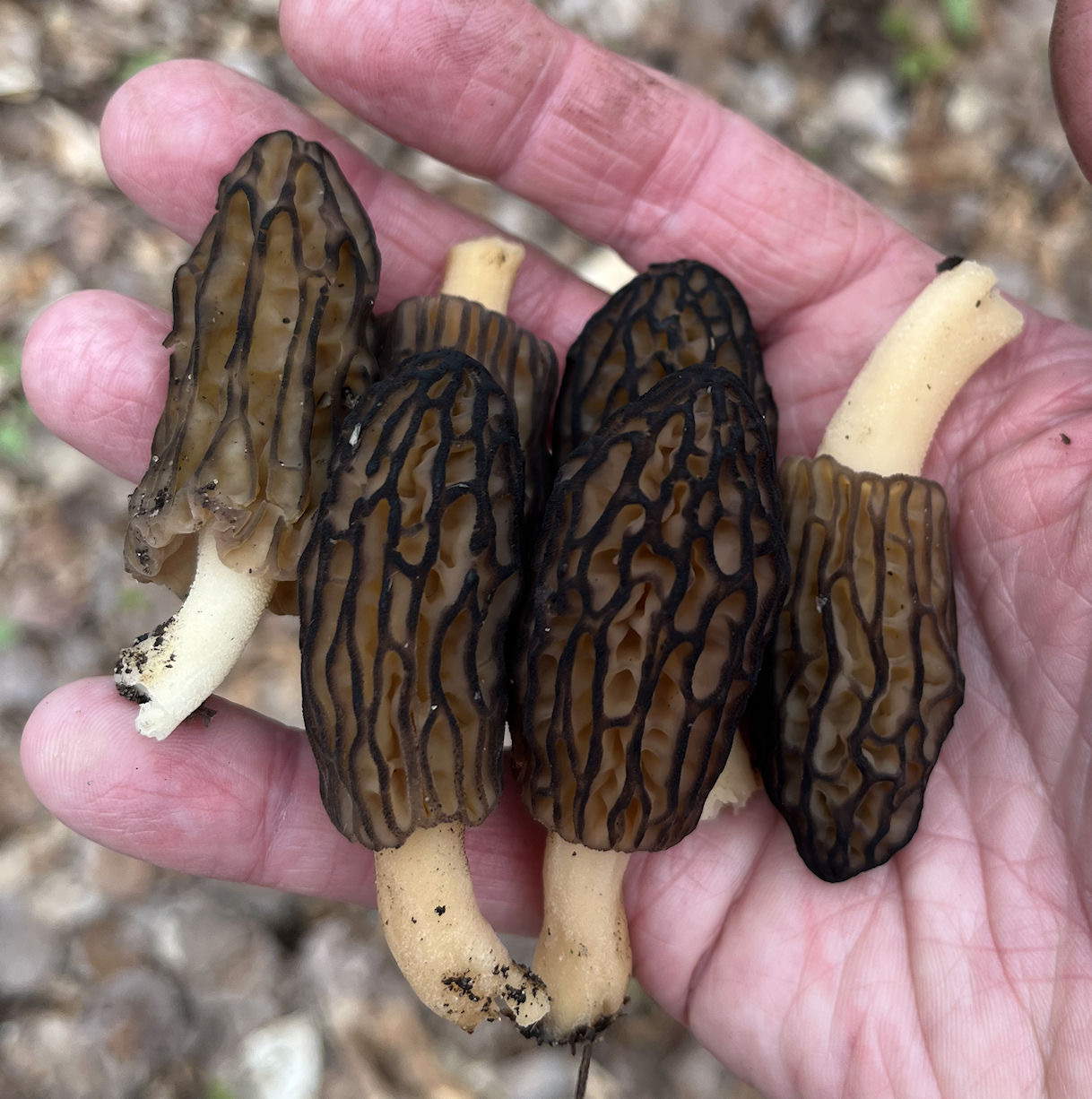American Chemical Society
| Industry
| Industry Matters Newsletter
| New Dangers In The Woods
New Dangers in the Woods
Industry Matters Newsletter
26 May 2022
Mark E. Jones, PhD
Morel mushroom hunting filled much of last week. The main
reason for May camping in northern Michigan is morels. Trekking through the deep
woods brought new appreciation for chemistry this year.

Morel mushrooms found in Michigan.
Dangers, at least in past years, were scarce in the morel
woods. It is rare to see animals, with the occasional porcupine being the most
dangerous looking, yet representing little real danger. I am now in my 32nd year
walking in the Michigan woods. This is the first time I’ve found a tick.
There are over
860 species of ticks
worldwide. Only about
20 call Michigan home, but they are
increasing.
Some have linked the increasing
range to climate. Cold keeps
arthropod pests at bay, but the coldest
temperatures are warming. Pests
now survive the milder winters. Some
link the growing deer and
populations and other
causes to
increasing range. Whatever
the cause, we now have at least five problematic ticks in the Michigan woods.
The
CDC lists 16 tick-borne
diseases present in the U.S.
Mercifully, all aren’t
yet in Michigan.
. All are scary.
A tick bite can also cause a potentially fatal
allergy to meat. An encounter
with a tick can be a life-changing event.
Ticks are an unwelcome addition to the
menagerie of bloodsucking beasts found in the wilds of Michigan.
There are pesky mosquitos, annoying black flies, and blood-sucking
leeches. I hate them all.
Amber-encased ticks tell us they’ve been around
since the time of the dinosaurs, just as Jurassic Park taught us about
mosquitos feasting on dinosaurs.
The prevalence of both, success over eons, and expansion indicate it must be a
ripe ecological niche. It is unlikely
they are going away. We will have to
adapt.
The adaptations available are decidedly
chemical. Chemophobic friends
willingly spray themselves, spray their yards, ignite chemical-containing
incense and, more recently, wear little chemical-spewing fans all in hopes of
keeping the bloodsuckers away.
“They don’t bite, they don’t even light” was
a memorable line in a TV commercial for insect repellents.
That commercial heralded the power of DEET, N,N-diethyl-meta-toluamide
or N,N-Diethyl-3-methylbenzamide. It is the most widely used insect
repellent, one I’ve used for years.
I’ve used Picaridin , or
1-methylpropyl 2-(2-hydroxyethyl)-1-piperidinecarboxylate.
DEET feels greasy. Picaridin
is non-greasy and odorless. Both are
proven to work on both mosquitos and ticks when applied to skin and clothing.
DEET can cause acute health effects, though it has never happened to me.
Seizures, uncoordinated movements, agitation, aggressive behavior, low
blood pressure, and skin irritation have all been
attributed to DEET use.
Picaridin has fewer
concerns.
Sadly, studies
aren’t kind to the natural oils.
Studies and my experience indicate the synthetics work better.
Pyrethroids loom large in arthropod abeyance.
Synthetic pyrethroids are compounds with structures similar to compounds
extracted from chrysanthemum flowers,
pyrethrins.
They are rapidly absorbed and paralyze insect nervous systems.
The DoD
preferred
system for bug avoidance relies on application of DEET or Picaridin to skin
and treating clothing and bed nets with
Permethrin,
(3-phenoxyphenyl)methyl
3-(2,2-dichloroethenyl)-2,2-dimethylcyclopropane-1-carboxylate, a synthetic
pyrethroid. Pyrethroids aren't
absorbed through human skin very well, but are not intended for direct skin
application. They do enter the body
if eaten or inhaled. Pyrethroids are
generally considered safe for humans, but
indiscriminately kill insects.
When used with DEET or Picaridin, Permethrin, on clothing is an effective
contact poison for a broad range of biting arthropods.
Ticks and mosquitos are no match.
Spatial repellents are things that keep bugs
away. Candles, incense and devices
emit repellents to form a bug free zone making the campsite livable.
They make a cloud of pyrethroid vapor that serves to disorient or kill
flying bloodsuckers.
Metofluthrin,
[2,3,5,6-tetrafluoro-4-(methoxymethyl)phenyl]methyl
2,2-dimethyl-3-(1-propenyl)cyclopropanecarboxylate, or other pyrethroids are
used in several of the most effective spatial repellants.
Volatilizing pyrethroids means breathing
them. They are rapidly absorbed
through the lungs. Measuring the
metabolite 3-phenoxybenzoic acid shows
the majority of us are already exposed to pyrethroids.
I am concerned, but, for now, willing to
trade breathing the vapors for fewer bites.
Some say the pyrethroids are safe, deemed
natural or
safe because their foundational structure comes from a flower. That perturbs
me. Pyrethroids are ubiquitous,
having replaced several classes of insecticides deemed more problematic.
They kill all insects, including bees.
They are highly toxic to fish and other animals living in salt water or
fresh water. We are only
beginning to understand the human health and
environmental toll of that widespread use.
Metofluthrin has a tetrafluorinated aromatic ring.
Permethrin is dichlorinated.
These compounds are far from natural.
Permethrin is listed by the EPA as a “likely to be carcinogenic to humans”.
Exposure was recently linked to
increased deaths by all causes.
If safe means incapable of causing harm, these compounds are far from safe, but
they may be safer than going without
My safety in the woods now depends on chemicals.
I will move to spraying my clothes with Permethrin to ward off ticks, in
addition to using DEET or Picaridin on my skin.
I will trade chemical exposure for reduced risk of arthropod-borne
disease, or at least for a reprieve from bloodsuckers.
As arthropod-spread diseases spike, I am trading risks.
